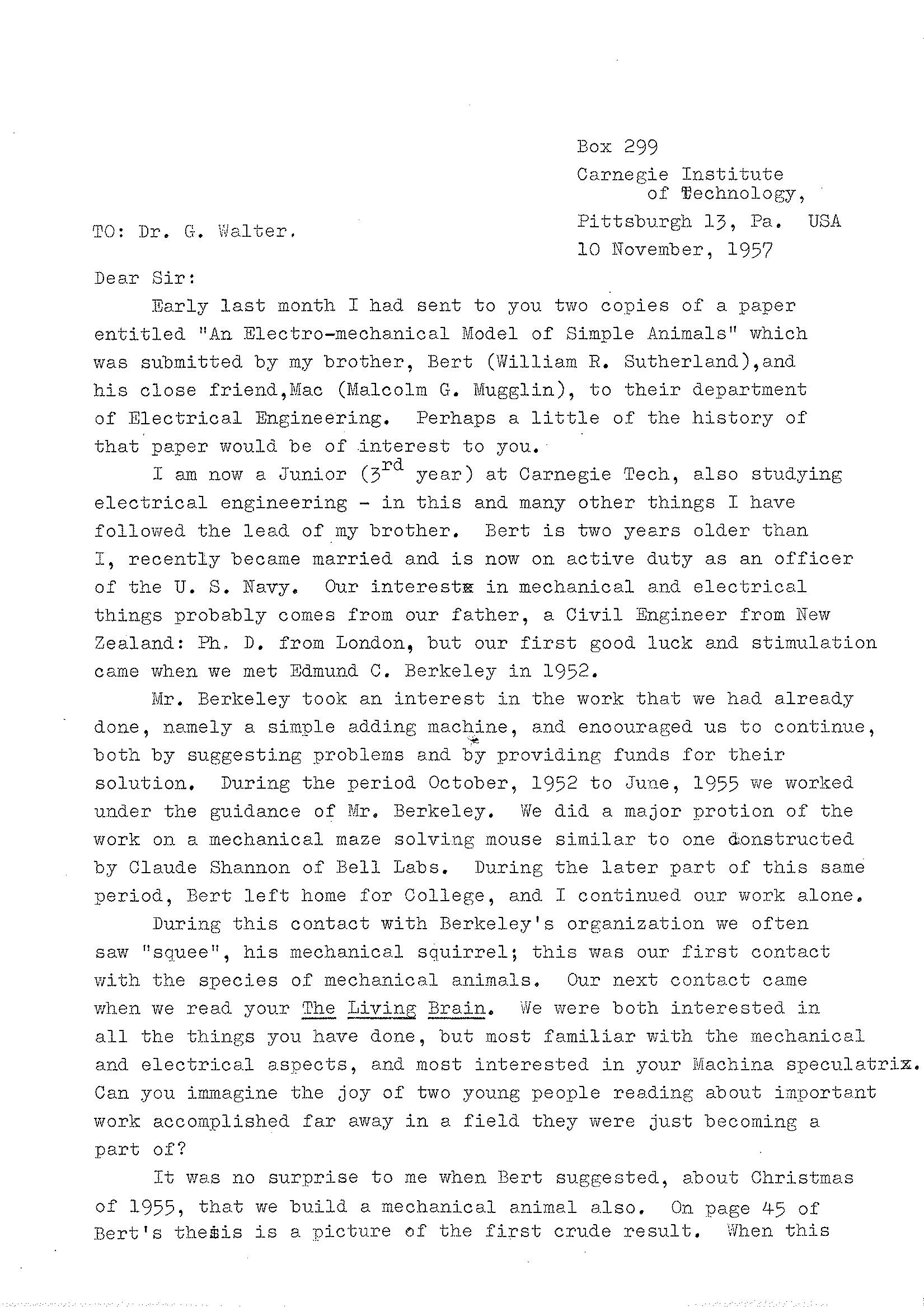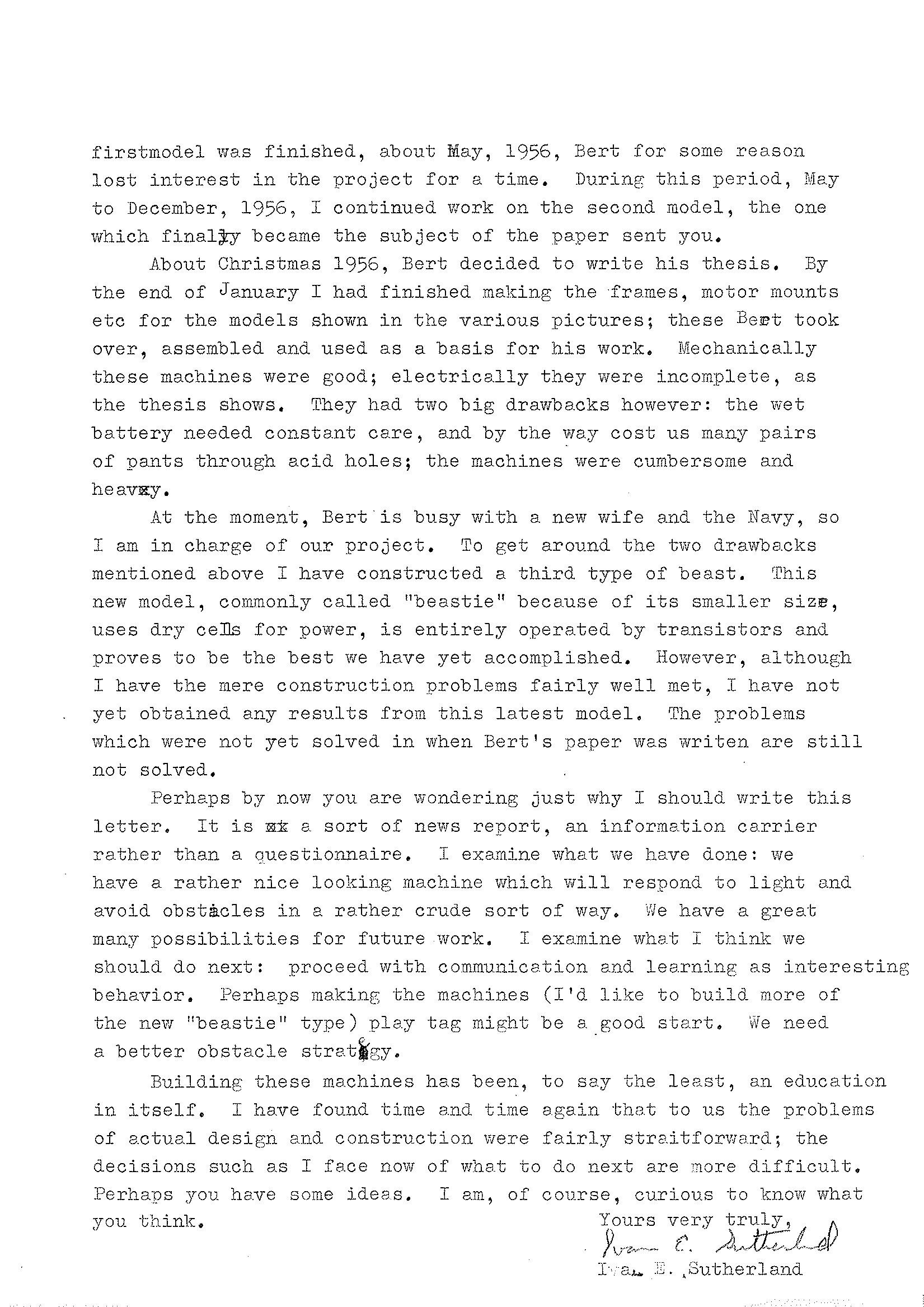Who is Ivan E. Sutherland? Ivan was born in 1938, Nebraska, USA and is a computer pioneer, inventing Sketchpad, being the first what we now call a Graphical User Interface (GUI). He also built a walking machine, but that will be the subject to another post later.
As an under-graduate student, Ivan, with his elder brother Bert, and Bert's then close friend Malcolm Mugglin built their first "beastie".
1957


Here's a transcript of the letter send from IEW to Grey Walter in 1957:
Nov 10. [IES to WGW]
“Dear Sir:
Early last month I had sent to you two copies of a paper entitled “An Electro-mechanical Model of Simple Animals” which was submitted by my brother, Bert (William R. Sutherland), and his close friend, Mac (Malcolm G. Mugglin), to their department of Electrical Engineering. Perhaps a little of the history of that paper would be of interest to you.
I am now a Junior (3rd year) at Carnegie Tech, also studying electrical engineering – in this and many other things I have followed the lead of my brother. Bert is two years older than I, recently became married and is now on active duty as an officer of the U.S. Navy. Our interest in mechanical and electrical things probably comes from our father, a Civil Engineer from New Zealand: Ph. D. from London, but our first good luck and stimulation came when we met Edmund C. Berkeley in 1952.
Mr. Berkeley took an interest in the work that we had already done, namely a simple adding machine, and encouraged us to continue, both by suggesting problems and by providing funds for their solution. During the period October, 1952 to June, 1955 we worked under the guidance of Mr. Berkeley. We did a major protion [sic] of the work on a mechanical maze solving mouse similar to one constructed by Claude Shannon of Bell Labs. During the latter part of this same period, Bert left home for college, and I continued our work alone.
During this contact with Berkeley’s organization we often saw “squee”, his mechanical squirrel; this was our first contact with the species of mechanical animals. Our next contact came when we read your The Living Brain. We were both interested in all the things you have done, but most familiar with the mechanical and electrical aspects, and most interested in your Machina speculatrix. Can you imagine the joy of two young people reading about important work accomplished far away in a field they were just becoming part of?
It was no surprise to me when Bert suggested, about Christmas of 1955, that we build a mechanical animal also. On page 45 of Bert’s thesis is a picture of the first crude result. When this first model was finished, about May, 1956, Bert for some reason lost interest in the project for a time. During this period, May to December, 1956, I continued work on the second model, the one which finally became the subject of the paper sent [to] you.
About Christmas 1956, Bert decided to write his thesis. By the end of January I had finished making the frames, motor mounts etc for the models shown in the various pictures; these Bert took over, assembled and used as a basis for his work. Mechanically these machines were good; electrically they were incomplete, as the thesis shows. They had two big drawbacks however: the wet battery needed constant care, and by the way cost us many pairs of pants through acid holes; the machines were cumbersome and heavy.
At the moment, Bert is busy with his new wife and the Navy, so I am in charge of our project. To get around the two drawbacks mentioned I have constructed a third type of beast. This new model, commonly called “beastie” because of its smaller size, uses dry cells for power, is entirely operated by transistors and proves to be the best we have yet accomplished. However, although I have the mere construction problems fairly well met, I have not yet obtained any results from this latest model The problems which were not yet solved in when Bert’s paper was written are still not solved.
Perhaps by now you are wondering just why I should write this letter. It is a sort of news report, an information carrier rather than a questionnaire. I examine what we have done: we have a rather nice looking machine which will respond to light and avoid obstacles in a rather crude sort of way. We have a great many possibilities for future work. I examine what I think we should do next: proceed with communication and learning as interesting behaviour. Perhaps making the machines (I’d like to build more of the “beastie” type) play tag might be a good start. We need a better obstacle strategy.
Building these machines has been, to say the least, an education in itself. I have found time and time again that to us the problems of actual design and construction were fairly straightforward; the decisions such as I face now of what to do next are more difficult. Perhaps you have some ideas. I am, of course, curious to know what you think.”
1959
July 13 ECB to Hy Nagourney of Science Materials Center (HN) – ECB spoken to WGW on recent visit to England and discussed possible manufacture of small robots.
Dec 19. IES to WGW
Dear Dr. Walter:
I have written a paper for the American Institute of Electrical Engineers which attempts to show how simple animals steer themselves. It considers, amongst other things, your Machina Speculatrix. This paper is soon to be published in Electrical Engineering, the monthly publication of the AIEE.
I would like to include a picture of Machina Speculatrix with my paper. Would you be so kind as to send a picture suitable for publication?
I am particularly interested in showing the “tricycle” [sic] type steering system which you used. A side view with the cover removed would, I think, be best. …..”
1960
Jan 23 [Ivan Sutherland to WGW]
“I thank you very much for the photographs of M. Speculatrix. ….I observed the numeral 6 stamped on several parts. Was this the sixth model you have built?
Feb 1. [WGW to IS]
“the number ‘6’ which you saw on the chassis is, as you guessed, the serial number of the model.
You may be interested to know that Basic Book Inc …., who run the Science Library, are proposing to manufacture these models for demonstration purposes.”
RH-Note – its interesting to note that Berkeley was including IES in on the tortoise deal Mar 1 1961.
1961
Mar 1. Berkeley invites Ivan Sutherland to join Science Materials Center. Berkeley writes "We would like very much for you to be associated with us at Science Materials Center in one or more projects, including particularly to small robot project. …..we could draw on all of Grey Walter’s and all of your ideas and capacities, in order to produce small robots which would be of scientific value and instruction. I am sure that we need your help in addition to Grey Walter’s in order to make a resounding success of this project.”
No further correspondence known of from Berkeley archive.
I will talk further in another post about Ivan and Bert about later cybernetic models, including Franken, the maze solver.